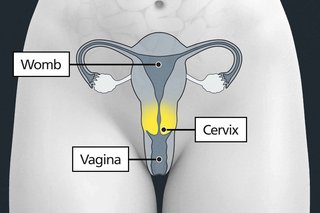See what the cervix is

See what a speculum and brush may look like

How cervical screening is done
- You'll need to undress, behind a screen, from the waist down. You'll be given a sheet to put over you.
- The nurse or doctor will ask you to lie back on a bed, usually with your legs bent, feet together and knees apart. Sometimes you may need to change position during the test.
- They'll gently put a smooth, tube-shaped tool (a speculum) into your vagina. A small amount of lubricant may be used.
- The nurse or doctor will open the speculum so they can see your cervix.
- Using a soft brush, they'll take a small sample of cells from your cervix.
- The nurse or doctor will close and remove the speculum and leave you to get dressed.
The cervical screening test itself should take less than 5 minutes. The whole appointment should take about 10 minutes.
Video: how cervical screening is done
This video shows someone having cervical screening. It shows an illustrated view of the inside of the body and explains what happens during the test.
Media review due: 4 February 2025
Important
You're in control of the cervical screening test and can ask to stop at any time.
Preparing for your cervical screening test
If you're worried about cervical screening, there are things you can try that might make the test easier for you.
Do
-
wear something you can leave on during the test, like a skirt or long jumper
-
bring someone with you for support
-
try breathing exercises to help you relax – ask the nurse or doctor about these
-
ask the nurse or doctor to use a smaller speculum if you feel any discomfort
-
ask if you can put the speculum in yourself if you would prefer to
-
ask about lying in a different position – such as on your side with your knees pulled up to your chest
-
bring something to listen to or read during the test
Don’t
-
do not feel pressured to keep going – you can ask to stop the test at any time
-
try not to be afraid or embarrassed to talk to the nurse or doctor – telling them how you feel will help them understand what kind of support you might need
Risks of cervical screening
You may have some light bleeding or spotting after cervical screening. This should stop within a few hours.
Non-urgent advice: See a GP if:
You've had cervical screening and have:
- heavy bleeding
- spotting or light bleeding that does not stop after a few hours